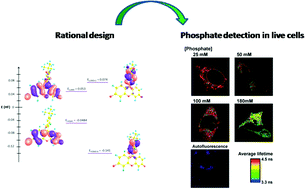Rational design of a new fluorescent ‘ON/OFF’ xanthene dye for phosphate detection in live cells†
Abstract
A new fluorescein derivative with ON/OFF features, 9-[1-(4-tert-butyl-2-methoxyphenyl)]-6-hydroxy-3H-xanthen-3-one (Granada Green, GG), was designed and synthesised. The new dye has spectral characteristics similar to those of other xanthenic derivatives but shows a higher pKa value for the equilibrium between its neutral and anionic forms. In addition, GG undergoes the same phosphate-mediated excited state proton transfer (ESPT) reaction as other xanthenic derivatives, giving rise to fluorescence decay traces that are dependent on both the phosphate concentration and pH of the medium. The phosphate-mediated ESPT reaction was employed to detect changes in the phosphate concentrations in live, permeabilised MC3T3-E1 preosteoblasts at pH 7.35. Its high pKa value indicates that this new dye is more sensitive as an intracellular phosphate sensor than other previously tested dyes, as experimentally demonstrated by its ability to detect a wider range of phosphate concentrations in biomimetic media and by the increased ratio of the phosphate concentration/decay time.



 Please wait while we load your content...
Please wait while we load your content...